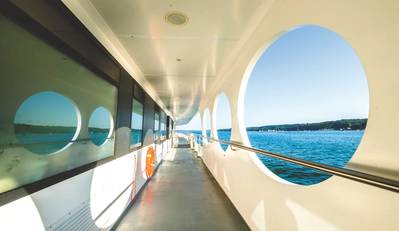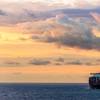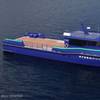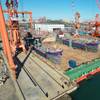How is COVID-19 Influencing Passenger Vessel Design?
Not long ago, at the start of 2020, the market for passenger vessel construction was booming, with record orders rolling in across the size spectrum, from small passenger vessels all the way up to the world’s largest mega cruise liners.
But then passenger vessels of all types and sizes began to empty out as COVID-19 spread. A large number of ferries were taken out of service or left operating with drastically reduced ridership (or in some cases, none at all) while the cruise industry—a related but separate species—was brought to a virtual standstill. The new construction business that was so strong quickly dried up. Many existing vessel orders were shelved or scrapped altogether, and the once steady stream of new orders was reduced to something less than a trickle.
Now, as travel and transit restrictions begin to ease in some locations, the passenger vessel industry is plotting for its eventual return to full service, complete with health and safety adjustments suited to the new coronavirus world. While the timing of any significant restart remains uncertain, the fact that safe operations will require a host of procedure and protocol changes is a given. Even design changes, especially to vessel interiors and onboard public spaces, are expected to come about.
Tomas Tillberg, a managing partner at Tomas Tillberg Design International, noted that even in the past, before COVID-19, there were high-profile cases of illnesses on passenger ships that led to an increased focus on sanitation measures on board as well as new rules and regulations for things such as hand washing and dining arrangements.
Of course, a strong focus on health and safety is nothing new for the passenger vessel industry. The current pandemic has simply amplified it as operators and designers hash out new solutions to the current situation.
“Now what we see occurring is companies will come up with new ideas and new materials and new design solutions that will be more cutting-edge in this aspect. And the companies that are on the forefront of that have a lot to gain,” Tillberg said.
Tillberg’s Florida-based company specializes in the design of passenger vessels. Carlos Reyes, the firm’s other managing partner, said the company is hard at work developing a number of solutions that will, first and foremost, keep passengers safe, but also help them to feel safe and comfortable on board.
“The selection of a given cruise line by the customer is not going to be driven only by the itinerary or the food, entertainment or the price; it’s going to be heavily driven by at what point you feel safe bringing your family on board,” Reyes said.
“From a design perspective, we are very conscious of the density of people in a given space,” Reyes said. “We are working on solutions that take advantage of the space the best we can and give the passenger the feeling that they are safe on board the ship.”
“One of the main elements that we believe will change will be the space per passenger ratio in public areas. People need to feel less crowded, which gives a sense of safety,” Reyes said. “For sure, the outside decks and open areas will be utilized more than before.”
Tillberg said the company is also examining the ways passengers move around aboard ships and how to create more open spaces and areas outside.
For the most part, reutilizing certain onboard spaces (such as open areas, for example) is fairly straightforward, Reyes noted, but he said this becomes much more challenging in other parts of the ship such as in high-traffic and heavily utilized passenger corridors.
“It’s a whole new family of ideas and designs you have to grapple with,” Tillberg added. “It’s a nice challenge actually, and I think sometimes these challenges bring forth better designs in general. We sort of get off the beaten track. We have to rethink things, which is very good from a design viewpoint.”
One aspect of passenger vessels that will be very important to consider along the uncharted course ahead is the types and properties of materials that are used in passenger spaces, and how they could potentially contribute to greater onboard health and safety. The development and choice of paints, flooring, fabrics, furniture, etc. are receiving more attention than ever before.
“We are looking at materials all the time. New materials are very important for us,” Tillberg said. “Now there is a lot of focus on what materials will help in preventing the spread of COVID. There are already suppliers who provide surfaces that are COVID-resistant and also that are very easy to clean. Even fabrics. This is something we’re looking at all the time. We rely on the manufacturers and the scientists they work with to develop these materials and we’re very alert to what comes out.”
While the newbuild market is unlikely to see any sweeping rebound anytime soon, that’s not to say there won’t be other opportunities for designers, yards and suppliers.
Reyes believes the reactivation and modification of the many passenger vessels that have been idled for months throughout the pandemic will provide significant market opportunities going forward. Health and safety will surely be at the forefront. “There will be a lot of opportunities, without a doubt, to work together with the cruise lines to come up with very innovative solutions,” he said.














